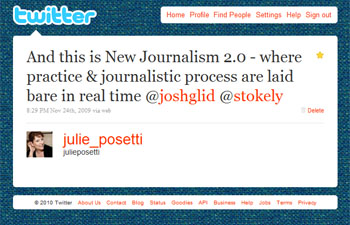The spectacular demise of the Australian conservative party’s leadership in November 2009 was a turning point for political journalism in the country. This is the third and final installment in a special MediaShift series (read part one here and part two here) about the transformative impact of the biggest Australian political story of 2009, which became known simply by its Twitter hashtag, #spill. The series is based on a case study featuring tweeting Canberra Press Gallery journalists, eight of whom I surveyed in the immediate aftermath of the story.
The conservative leadership spill, which unfolded in real time over two of the longest weeks in the history of the Liberal-National coalition, highlighted the emergence of a new form of political communication via Twitter. This was characterized by instant, multi-contributor, user-controlled information feeds. These feeds accommodate the transmission of breaking news; instant reaction, critiques and analysis; and live interaction between the the Fourth Estate and citizens, with occasional input from politicians. The aggregation of Twitter discussion about the leadership crisis using the #spill hashtag enhanced Twitter’s role as a journalistic platform for broadcast and audience engagement, and highlighted its emergence as a critical news source for Press Gallery journalists.
Participatory Democracy
“Now when it comes to politics, there’s virtually no difference between journalists camped outside the party room and voters in Sydney, Perth or on the other side of the world. Instantaneous live coverage is just a tweet away,” wrote Crikey’s Canberra correspondent Bernard Keane in the grip of the #spill. He was speaking about the collapsing of boundaries between political journalists and “the people formerly known as the audience,” as Jay Rosen famously wrote.
Australian journalist and consultant Bronwen Clune re-purposed Rosen’s quote, telling the Sydney Media140 conference last year (just a few weeks before the #spill erupted) that “journalists are the audience formerly known as the media.” During the coverage of the #spill, it became clear that tweeting Australian political journalists _were _ playing a new role: as audience members and consumers of citizen-generated political observation and commentary.
The aggregation of #spill tweets under one hashtag had a leveling effect: The tweets of Press Gallery journalists intermingled with those of political scientists, politicians, bloggers and ordinary citizens using Twitter as a platform for democratic participation. This was a point acknowledged by Keane, who described the effect as a “flattener…ironing out the differences between members of the public, even on the other side of the world, and veteran insiders in Parliament House.”
The process also facilitated engagement, predominantly between external commentators and observers (both professional and amateur) and Press Gallery journalists. While talk show hosts are used to having direct contact with audiences, professional journalists — particularly those occupying well-insulated senior positions inside large news organizations — have historically been shielded from direct engagement with their audiences and, to an extent, the reactions of people on whom they report.
The breaking down of the barriers between the professional journalist and the media consumer is a significant change being facilitated by Twitter. #Spill played a major role in helping bring this change about.
Real-time Feedback for Media Messengers
One of the most interesting aspects of the affect of Twitter on professional journalism is the impact of real-time feedback on those used to being in control of the message — the chance for an instant critique. As The Age newspaper’s Misha Schubert observed: “Once upon a time newspaper readers would call us or write lovely long letters in spidery handwriting suggesting directions for a story, or relating great anecdotes. Now that process also happens instantly on Twitter.”
But while some #spill commentators used Twitter as a tool for correcting the record — pointing out mistakes and misperceptions to journalists, for example — and complaining about an angle, there was a common theme of gratitude towards tweeting journalists. Stephen Murray, a politically engaged Australian Twitter user, tweeted, “Thanks to latikambourke annabelcrabb samanthamaiden David_Speers for letting us tweeters in on the 1st draft of history.” What Murray and others really appreciated was being given front row, interactive seats to view the drafting process.
Schubert also alluded to the 3D effect of Press Gallery journalists’ tweets. “I think (they) drew readers into the parliament, giving them a chance to follow events as if they were cantering down the halls along with those of us lucky enough to do this for a living,” she told me.
But how do the journalists feel about receiving instant feedback? While some privately express resentment at being subjected to harsh criticism from consumers of their work, those I surveyed said they enjoyed the experience.
“I like the direct audience feedback,” said ABC Radio’s chief political correspondent Lyndal Curtis. “I like that people can get a sense of what it is like to be a journalist in the eye of a storm like a leadership challenge. I think it is worthwhile for people outside the bubble to see it.”
Political Engagement
Along with citizens and journalists, the third essential prong for democratic engagement is the politicians themselves. During the #spill, one of the conservative leadership contenders, Joe Hockey, interacted with constituents via Twitter, although too many Australian politicians use Twitter like an old telex service for distributing press releases.

One of their objectives in using the medium is to bypass the journalistic information gate-keepers. Ironically, instead they find themselves entwined with journalists in a three-way political communication process which is ultimately controlled by the voters. Instead of being held to account only by professional journalists, they’re also being questioned, corrected and challenged by active citizens.
Kristina Keneally, the premier of New South Wales, the biggest Australian state, discovered this recently when she responded to Twitter questions from journalists and constituents challenging her excuse for being absent from Parliament during a vote on gay marriage.
Risks of Political Tweeting
The journalists who participated in this survey acknowledged some downsides associated with tweeting political news. Two out of the eight journalists I spoke with mentioned the problem (or perception) of inaccuracy often associated with the medium.
“There is no doubt that Twitter updates, being of the moment, can be incomplete,” said Annabel Crabb, the ABC’s chief online political correspondent. “They are sometimes inaccurate. They are easily superseded.”
But she went on to highlight the benefits of real-time reporting of political news, particularly fast-paced stories like the #spill. She said this provides “an insight into the minute-by-minute business of politics, and in times like the last fortnight, I think such an insight is definitely worthwhile.”
ABC Radio’s chief political correspondent Lyndal Curtis pointed to the internal editorial impact of Twitter on her capacity to cover the #spill accurately from her Canberra Press Gallery front row seat.
“I had to spend some time talking to my colleagues in Sydney and telling them that what they were seeing on Twitter was wrong,” she said.
Her colleagues based in Sydney (the home of the programs Curtis files for) partly formed their reading of events on the basis of Twitter feeds from journalists attached to competing media outlets.
“Sometimes it’s not the fault of the journalists — in a fast moving and bizarre story as this one was…things have to be checked with more than one person…something you may believe to be right can be wrong the next minute,” Curtis explained.
Inaccuracy or Realities of Real Time?
What Curtis is highlighting is not necessarily inaccuracy, but rather the reality of real-time reporting where facts change rapidly. This creates the impression of inaccuracy when a story shifts. It’s is a common peril of live broadcasting, which compels journalists to go to air with what they know, when they know it. It’s also a reality of print journalism: When a newspaper is put to bed at night, the front page may accurately reflect a changing story, but then appear inaccurate in the morning thanks to facts that emerged overnight.
This is not to diminish the importance of fact-checking (either individually, collectively or via crowdsourcing), but to point to the nature (and perils) of rolling or iterative reporting. As Samantha Maiden noted: “I suspect you would find in such a chaotic, fast-moving environment that mistakes were made in old and new media alike.”
The speed with which mistakes can spread via the re-tweet function of Twitter, and the associated need for quicker correction, was noted by three of the journalists. Radio 2UE correspondent Latika Bourke also pointed to the competitiveness between journalists on Twitter as a factor.
“There is even greater pressure to be first and the pitfalls of being wrong are greater, because of the ability to re-tweet, which can send your mistake farther than you can imagine, before you’ve even had time to correct, or delete,” she said.
As more than one journalist has already discovered, you can never really delete an inaccurate tweet, and doing so can create the impression of dishonest reporting. However, journalists’ Twitter slip-ups were limited during the #spill coverage thanks in part to an informal peer-review process that also ensured necessary corrections were made almost immediately, according to Crikey’s Keane.

“Given that journalists on Twitter knew they were being monitored and relied on by their peers, I suspect that played a role in keeping the tendency to report poorly-sourced information or rumors down,” he said. “There were only a couple of occasions when outright wrong info was circulated, and it was retracted by those who had done so once they realized it was wrong.”
What Does the Future Hold?
This snapshot of a case study of Australian political journalists’ use of Twitter as a reporting tool highlights the transformative effect the micro-blogging platform is having on journalism practice: Sharpening competitiveness, collectivizing reporting efforts, and rendering processes transparent.
It’s also demonstrated the Twitterization of political news consumption, which delivers real-time access to the corridors of power, with engagement between journalists, between citizens, and between citizens, journalists and politicians.
But is the change permanent, or is this just a fleeting shift in times of great industry upheaval? I contend that the lessons being learned and the change being wrought is likely to have a permanent affect. But Crikey’s Keane suspects the transparency Twitter has delivered will ultimately prove short-lived.
“What I suspect will happen more and more is that journalists will treat Twitter the same as other media — they’ll start hoarding info for commercial advantage,” he said. “We’re in an unusual spot on Twitter…but more traditional media practices will kick in soon enough.”
Nevertheless, he concedes Twitter will continue to be front and center in fast-paced stories like the dramatic leadership challenge that was the #spill, “where a certain competitiveness overtakes everyone to see who can report via Twitter whatever they’ve found ASAP.”
The very popular political tweeter Latika Bourke said Twitter, or something like it, is here to stay. “Maybe the platform will change over time, but having seen the hunger for coverage of the #spill (my followers doubled to more than 2200 in a week), I don’t think Twitter, or it’s equivalent, will ever disappear,” she said.
The last words in this MediaShift series belong to Keane, who wrote of the impact of Twitter on political reporting within 24 hours of the story breaking: “This is fundamental change in political journalism…Sometimes all that rubbish we go on with about media revolutions is actually true.”
Julie Posetti is an award winning journalist and journalism academic who lectures in radio and television reporting at the University of Canberra, Australia. She’s been a national political correspondent, a regional news editor, a TV documentary reporter and presenter on radio and television with the Australian national broadcaster, the ABC. Her academic research centers on talk radio, public broadcasting, political reporting and broadcast coverage of Muslims post-9/11. She blogs at J-Scribe and you can follow her on Twitter.

